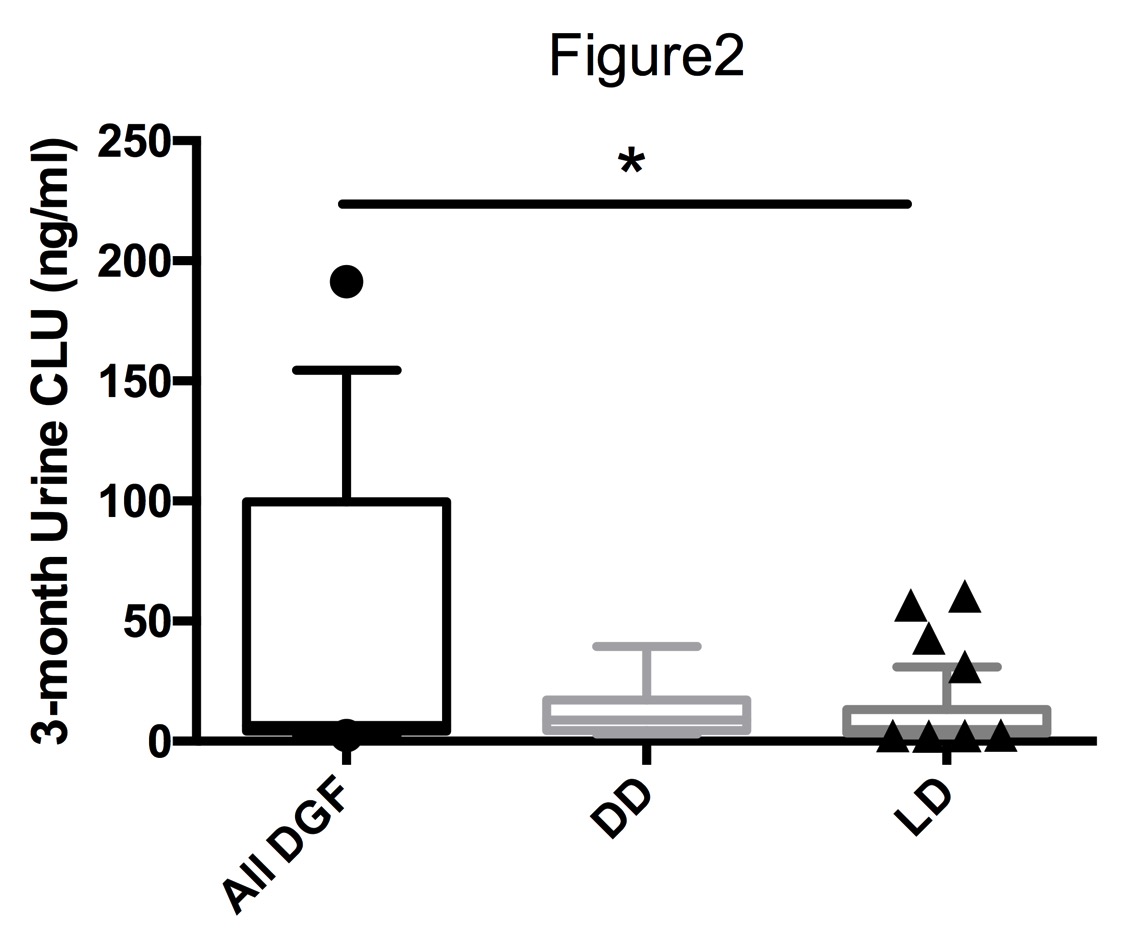Clusterin Levels at 3-Months Associate with DGF and 12-Month Fibrosis – Reinforcing the Early Injury to Fibrosis Continuum.
1Medicine, Nephrology, Icahn School of Medicine at Mount Sinai, New York, NY
2Medicine, Westmead Millenium Institute, Sydney, NSW, Australia
Meeting: 2017 American Transplant Congress
Abstract number: A122
Keywords: Genomic markers, Graft function, Renal injury
Session Information
Session Name: Poster Session A: Diagnostics/Biomarkers Session I
Session Type: Poster Session
Date: Saturday, April 29, 2017
Session Time: 5:30pm-7:30pm
 Presentation Time: 5:30pm-7:30pm
Presentation Time: 5:30pm-7:30pm
Location: Hall D1
The Genomics of Chronic Allograft Rejection (GoCAR) is a multicenter study investigating the ability of gene expression to predict the development of Chronic allograft nephropathy. Serial allograft biopsies were obtained post-transplant with Chronic allograft dysfunction index score (CADI) reported from a core lab. Gene expression microarray analysis was performed on 3-month biopsies (Affymetrix: human exon-1chip; n=159), and correlated to CADI-score at 12-months. We identified that Clusterin-expression (CLU) in 3-month allograft biopsy correlated linearly with fibrosis, and negatively with eGFR at 1 year (n=147; p<0.01). Other publications have associated CLU-levels by ELISA in urine, immediately post-transplant with delayed graft function (DGF). In our discovery GoCAR cohort, we interestingly observed that mean allograft CLU-expression even at 3-months was significantly higher in allografts that had had DGF (P=0.02). We hypothesized that CLU-levels in urine at 3-months may show similar relationships, and serve as evidence for ongoing injury and for CADI-progression. In a separate validation cohort of transplant recipients (n=65; 25 deceased donors & 40 living donor), we collected clinical data and serial urine samples at 3, 6 & 12-months post transplant. We performed ELISA for CLU in these samples. Again we identified that patients with DGF (n=14) had a significantly increased level of urinary clusterin that persisted even at 3-months, compared to Living donors (n=41; 47.24 vs 11.33 ng/ml, P<0.001). Normalization to creatinine and complete 12-month eGFR in this validation cohort is being currently accrued. In summary, our preliminary data identified Clusterin (CLU) as a novel candidate gene whose 3-month allograft expression precedes and correlates with the progression of fibrosis in allografts. CLU-mRNA in allograft and protein levels in urine may associate with DGF, suggesting a potential role for CLU as a marker of continuing allograft injury that begins at transplantation.
Normalization to creatinine and complete 12-month eGFR in this validation cohort is being currently accrued. In summary, our preliminary data identified Clusterin (CLU) as a novel candidate gene whose 3-month allograft expression precedes and correlates with the progression of fibrosis in allografts. CLU-mRNA in allograft and protein levels in urine may associate with DGF, suggesting a potential role for CLU as a marker of continuing allograft injury that begins at transplantation.
CITATION INFORMATION: Menon M, Liriano-Ward L, Philippe N, Wei C, Zhang W, Yi Z, Keung K, O'Connell P, Murphy B. Clusterin Levels at 3-Months Associate with DGF and 12-Month Fibrosis – Reinforcing the Early Injury to Fibrosis Continuum. Am J Transplant. 2017;17 (suppl 3).
To cite this abstract in AMA style:
Menon M, Liriano-Ward L, Philippe N, Wei C, Zhang W, Yi Z, Keung K, O'Connell P, Murphy B. Clusterin Levels at 3-Months Associate with DGF and 12-Month Fibrosis – Reinforcing the Early Injury to Fibrosis Continuum. [abstract]. Am J Transplant. 2017; 17 (suppl 3). https://atcmeetingabstracts.com/abstract/clusterin-levels-at-3-months-associate-with-dgf-and-12-month-fibrosis-reinforcing-the-early-injury-to-fibrosis-continuum/. Accessed December 16, 2025.« Back to 2017 American Transplant Congress
